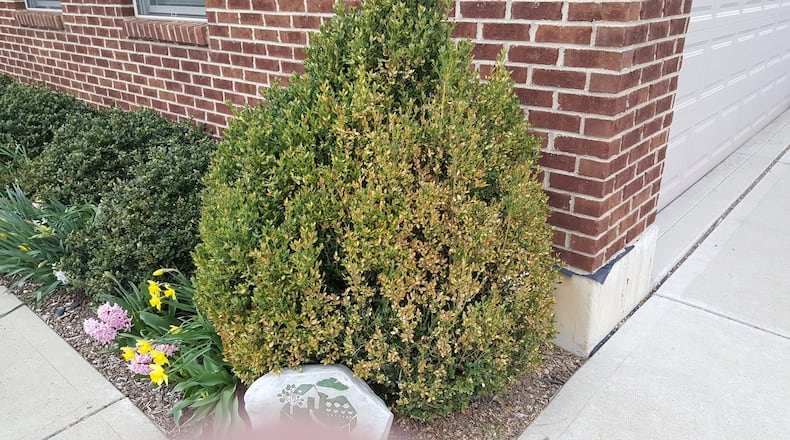Boxwoods are susceptible to winter burn and the symptoms show up as discoloration around the margin or edge of the leaf. The border of the leaf looks like it has dried out.
Broadleaved evergreens such as boxwood, holly and others are susceptible to winter burn. In the winter, the soil is frozen and the roots can’t take in moisture. As wind blows across the leaf surface, the leaf dries out around the margin, usually in an even pattern. Keep this in mind.
The boxwood leafminer is a midge fly that lays her eggs in the leaves of boxwoods. The larvae hatch and begin feeding in the early summer.
These larvae spend their life in the leaf, between the upper and lower surface. In the spring, they feed (right now) and then pupate. After pupation, the adults emerge and egg-laying begins all over.
As the pupae prepare for the emergence, you may even hear a hissing noise if there are high populations. The pupae wiggle around the lower leaf surface, creating weakened leaf tissue in order for the new adults to emerge.
This activity sometimes sounds like your plants are going snap, crackle and pop, according to OSU Extension, Hamilton County entomologist Joe Boggs.
The damage to boxwood leaves from the leafminer is much different than the damage caused by winter burn.
Remember that winter burn symptoms show up around the leaf margin whereas boxwood leafminer damage is all over the leaf, making it appear slightly spotted. In addition, if you look at the plant from a distance, it looks sort of off-color, and somewhat yellowish.
My Green Gem boxwood at the corner of the house has an extremely high population of this pest, and it is quite noticeable from a distance at this time. If you gently separate the top and bottom layers of the leaf, you may even find the maggots (larvae).
The recommended control for this pest is imidacloprid applied after the boxwoods bloom (to protect the bees). Mine are close to end of bloom.
Look for a pesticide at the garden stores that have ornamental plants (trees and shrubs) listed on the label as well as the active ingredient imidacloprid. Apply this to the soil and be sure to follow instructions. This will control the next generation of larvae that hatch late this spring.
About the Author
